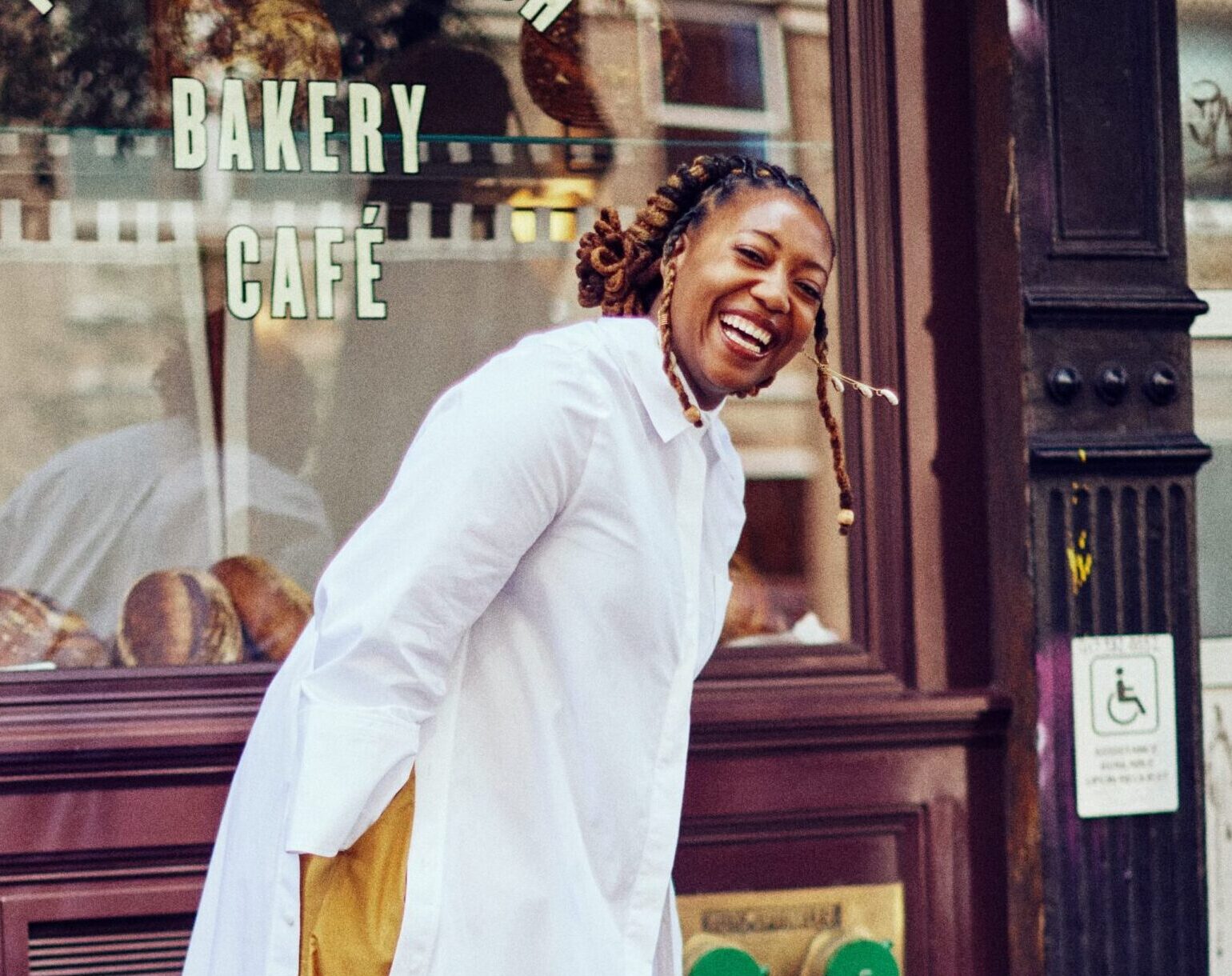
Watching Camari Mick bake is watching a woman in her element. She presses her finger assertively on the blade of an icing spatula, spreading whipped crème frâiche atop a thin layer of rum cake. Her fingers tuck the edges of the cake into itself. She pulls, carefully, deliberately, gaining momentum inch by inch—we suddenly have a log cake. There is no bead of sweat glistening on her brow, no face furrowed in consternation. Instead, she answers my questions readily, sneaking in a little joke or a hearty laugh. She brings me into her world with a lick of crème frâiche, and I take mental images of her technique for my next baking project. So when Mick tells me she hopes to be a mentor for black and brown chefs, I believe her.
We are in the kitchen of the Grace Hopper Head of College House, where in an hour, Mick will be speaking to food aficionado undergraduates about her career, which has grown exponentially in recent years. As the executive pastry chef of New York’s one-Michelin-starred The Musket Room and French-Italian bakery Raf’s, she has earned a spot in Forbes’ 30 Under 30 list, Food & Wine Magazine’s Best New Chef award, and a semifinalist ranking for the James Beard Foundation’s Outstanding Pastry Chef—all in 2024. She is perhaps most well-known for desserts inspired by her Jamaican and Southern heritage. Her jerk ice cream, when paired with a goat tres leches, transforms the classic Jamaican method of seasoning and smoking meat into a complex dessert. She reimagines Southern sweet potato pie with roasted sweet potato mousse, smoked molasses ice cream, and aquafaba meringue. Even the creation in front of us, her version of a Yule log, is an iconic French confection turned into a Jamaican rum cake. Under her hand, seemingly disparate culinary narratives intertwine to say something entirely new.
Her habit of merging French pastry with her Jamaican culinary heritage is no radical departure from the globalised way that the French pastry tradition developed. “All France really did was go to these different countries [through] colonization and brought back all this information,” she says. Pointing out that similar culinary techniques exist across cultures, Mick reasons that the French pâtisserie tradition is a mélange of global influences rather than a unicultural movement. “The French were just the ones to write it down,” she says. In that light, her desserts, innovative as they are, reflect an existing continuity between global culinary cultures.
It is a tenuous line to walk. French cuisine conjures images of pristine white tablecloths, impeccably-dressed waiters and intricate dishes, while Jamaican cuisine is often relegated to the realm of street food. Nonetheless, Mick resents the idea of “elevating” the cuisine. “It doesn’t need elevation. It’s beautiful in its own right,” she says. But how else does she describe her desserts destined for a fine dining table? “We’re just putting our own lens on it.”
Mick has developed a culinary repertoire as varied as Italian dolci to Japanese pastry. But there’s a more personal connection when it comes to her own culinary heritage. As a child of an immigrant parent, taking nostalgic flavours and twisting them into something new reflects, for her, a vision of the “new American family”— one that is all about integration and interrelation. In her kitchen, that also means uplifting black and brown voices.
—
Mick was born in eastern Pennsylvania to a Jamaican father and a Southern mother — both excellent cooks within their respective culinary cultures. Mick’s childhood dining table was decked out in sumptuous dishes touched by the traditions of the Caribbean and the American South. But Mick’s parents were not great bakers. Craving something sweet at the end of meals, Mick picked up the whisk and started baking with her mother. Soon enough, Food Network became regular programming in the household, and she would experiment with online dessert recipes. It became her calling—so much so that in elementary school, Mick started applying to pastry schools for fun. “I was a little devious,” she says with a grin, explaining how she would apply to study French pastry during computer hour. “[The schools] would call my mom and say, ‘We would like to talk to Camari and see how we can get her here.’” It fell onto her mother to explain that Mick was only eight years old.
Though Mick nurtured her love for baking throughout high school, where she started selling her own pastries, it wasn’t always apparent that she would become a pastry chef. As a teenager, she wanted to be a forensic pathologist. “My dad was like, ‘Are you sure about that?’” she recounts. Today, Mick credits her parents for pushing her onto her trajectory as a pastry chef. Knowing that any other path wouldn’t fulfill her, they supported her passion for pastry, she says. Mick doesn’t take this support for granted. Being in no way pressured to go into medicine or law, as many children of immigrants are, Mick pursued a Bachelor of Science in pastry arts at the Restaurant School at Walnut Hill College. From there, she worked at a number of fine dining restaurants by some of the most famous chefs in the country—including db Bistro Moderne by Daniel Boulud, the now-defunct TAK Room by Thomas Keller, and the three-Michelin-starred New York stalwart, Le Bernardin, by Eric Ripert.
Still, working at these establishments was not as glamorous as one would expect. When I ask her about her experience in those kitchens, Mick pauses her spatula, leaving the Yule log half-covered in ganache. She gathers her words carefully. “I’ve trauma-bonded with some people [who’ve worked there],” she says. “It’s just one of those spaces where you will never feel seen.” She was often the only black person in the kitchen, and nobody would take her side if someone said something blatantly racist. Physically taxing days—”ten-hour days, six days a week”—were made more unbearable by a “cutthroat” environment laced with sabotage. Other chefs would replace Mick’s sugar with salt to get her into trouble, she recounts. Besides, the restaurants were so traditional that there was no room for ingredients such as jerk on the menu. “That’s fine, there’s a certain market and demographic for that,” she says, referring to the conservative palates that these restaurants cater to. “I just don’t fit into it.”
To an extent, the lack of black and brown representation in the restaurant industry is a generational issue. “When you look at the generation before us, it’s all old white male chefs,” she says. “All the chefs that I’ve been miserable under have been white, straight men.” But the restaurant industry might just be a microcosm of larger social dynamics that Mick is no stranger to. Back in her “hyper-white” corner of Pennsylvania, the classroom was also a place where Mick was the only black person. Her family became an important community for her. As a chef, being in predominantly white spaces meant that she never explored her own culinary culture until much later. Tied implicitly to her culinary heritage were fundamental questions about her personal identity, which required hours of introspection, reflection and therapy. “How do I uplift the black community?” she asks. “Who do I want to be? What legacy do I want to leave behind? Who am I?”
_
On the counter next to Mick’s workstation is a bottle of Ten to One dark rum, a rum brand owned by her friend, Trinidadian-native Mark-Kwesi Farrell. Three-quarters cups of that rum has gone into the Yule log, now fully coated in whipped crème fraiche and sprinkled with chocolate crumble, a concoction of baked flour, butter, and cacao powder.
Whenever Mick needs to use rum, she reaches for the Ten to One first. In 2023, she started including it in desserts for events such as the International African American Museum’s opening, as well as a six-course menu celebrating Caribbean Heritage Month. Her collaboration with Farrell is an example of the mutual support that Mick tries to create within the industry. Indeed, she has found a community—or what she calls a “gaggle”—of black and brown chefs trying to bring their cultural cuisines into the dining scene. Collaboration dinners, where chefs join hands to deliver a one-off dining experience, are just one way in which community bonds are forged. Otherwise, it could be the rendering of assistance for a special dinner or event, or even a repost on Instagram. “It’s creating spaces in which we can highlight one another,” she says.
For Mick, this community did not materialize until she had a clearer idea about what her culinary style was going to look like. Her style might not have developed as quickly as it did were it not for the onslaught of the pandemic, which left her with lots of time on her hands to explore and bake. In 2020, Mick started running pop-up experiences, including Maison Yaki’s Black Entrepreneur Series, which featured black culinary voices in the food and drink industry. On the side, Mick also started selling donuts on Instagram. She hand-delivered pastries to her clients, one of whom happened to be Nicole Vitagliano, co-owner of The Musket Room with her sister, Jennifer. They called Mick in for an interview; she was hired on the spot. That year marked the first time that Mick had had the platforms to create her own menus, allowing her to experiment with her traditional pastry training and her Jamaican roots.
As Mick discovered the joy of incorporating her culinary heritage into her creations, she — alongside other black and brown chefs during the pandemic — also started questioning the dearth of fine dining restaurants that highlight black and brown cuisines in the United States. Thus, “How do I grow our industry?” is a question that Mick asks herself often.
Her answer is mentorship. A lot of chefs at Mick’s level have figures who guide them outside of the restaurant. Mick has had none — “especially one who looks like me,” she says — which spurred her decision to take on a mentorship role and “uplift black and brown voices in the culinary space”.
That’s already happening at the Musket Room kitchen. Mick tells me about her first hire, Quilla Gamarra, a Peruvian cook who’s been working with her for four years now, and who recently had their own spotlight dinner with the James Beard Foundation. The fulfilling part, Mick explains, was not just seeing them grow; it was also seeing them explain their love and connection to the dessert instead of simply reciting the ingredients and techniques they used. “That’s what I always want to embed in people. There’s so much we can do with food. We can let it talk for us.”
___
Holding a fork in one hand and a meringue mushroom head in the other, Mick carefully makes a small incision at the head’s base. She picks up a meringue mushroom stem, dips its pointed tip in crème fraiche, and affixes it to the head. There we have it — little champignons dotting the Yule log. Complete, the cake revels in its playful artifice.
The cake is a fine exemplar of her style, which she describes as “whimsical” and “perfectly unnatural.” But to Mick, substance is as important as style. Her eyes light up when she tells me about her newest dessert on the Musket menu: a cranberry bean mousse with huckleberry jam and bay leaf hazelnut shortbread. According to her, it is a riff on bean pie — a dish associated with the Black Power movement, when the Nation of Islam and the Black Panther Party would carry out free breakfast programs and after-school programs for Black communities. Eventually, Mick hopes to open a restaurant in Jamaica and establish programs that give back to the local community.
Mick is certainly no stranger to how intertwined food is with culture and existence. While her desserts embody narratives of history, struggle, empowerment, and kinship, her endeavors outside of the kitchen strive to bring that community beyond the plate and into the dining scene. That is the kind of chef that Mick strives to be.







